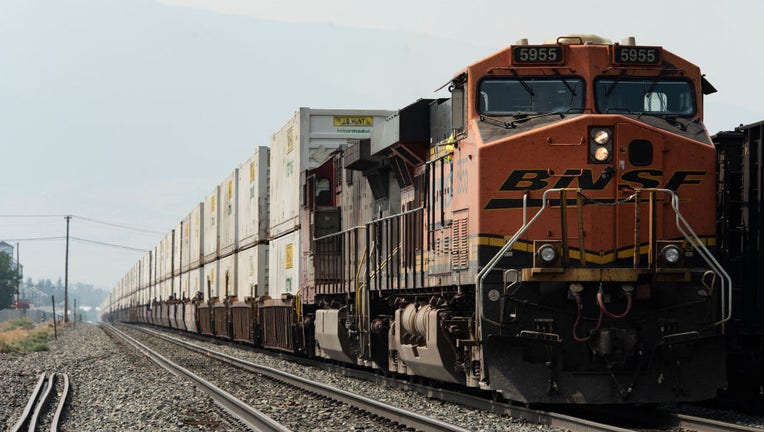Massive rail strike could mean more supply chain issues

A BNSF freight train with 76 container cars and FedEx freight trailers travels from Seattle to points east on August 23, 2021 in Livingston, Montana. (Photo by William Campbell/Getty Images)
A potential strike involving thousands of railroad workers poses a new threat to businesses nationwide.
Unions representing over 115,000 workers are poised to go on strike on Friday, Sept. 16 if a new labor agreement isn’t in place.
A stoppage of freight cars impacts shipments and could be detrimental to the U.S. economy because there would be a scarcity of items on store shelves, and the cost of goods would increase amid high inflation.
Last week, the Association of American Railroads trade group released a report projecting that the economy would take a $2-billion-a-day hit if trains stop moving. The report added that passenger traffic could be disrupted because Amtrak and other commuter railroads use tracks owned by the freight railroads.
A spokeswoman for the trade group said Sunday that railroads had to take action to prepare for a possible work stoppage because the deadline is so close, but the industry remains committed to negotiating an agreement with its unions.
What led to talks of a potential rail strike?
According to the Associated Press, railroad workers have gone without a raise since 2019 while the contract talks continued. The workers expect to be compensated after staying on the job throughout the pandemic and enduring extensive job cuts in recent years.
The major freight railroads have eliminated nearly one-third of their jobs over the past six years as they overhauled their operations to run fewer, longer trains that need fewer locomotives and employees, the AP reported in August. Unions explained to the AP that the railroad companies expect more from the workers who remain, and that some railroads' tightened attendance policies make it hard to take time off because of all the job cuts.
RELATED: LEGO raises prices, citing supply chain issues
Many of the companies who ship goods on the rails, labor groups and regulators blame the railroads’ current shipping problems on those deep worker cuts. But the railroads say the nationwide worker shortages and difficult hiring environment has kept them from hiring enough workers to handle all the shipments as the economy recovers.
In the contract talks, the unions also opposed railroad proposals to cut train crews down from two people to one. Union officials tell the AP they don’t want to strike but they appear ready to act if it does come to that. The Brotherhood of Locomotive Engineers and Trainmen said that more then 99% of its members voted to authorize the union to go on strike if a deal can’t be reached.
Biden administration gets involved in strike
A White House official said President Joe Biden and members of his cabinet were in touch with the unions and railroads Monday as part of their efforts to avert a strike. And for the second time in the past week, Labor Secretary Marty Walsh sat down at the negotiating table Sunday to urge the parties to reach a deal. Walsh postponed a planned to trip to Ireland this week to remain close to the talks.
On July 15 , President Joe Biden blocked a freight railroad strike for at least 60 days and appointed a Presidential Emergency Board (PEB) to intervene in the contract dispute, avoiding action that may have disrupted shipments. Any strike or lockout would be delayed 60 days under the federal law that governs railroad contract talks.
The move kept 115,000 rail workers on the job while arbitrators developed a set of contract recommendations for both sides to consider. The 60-day period is set to expire at 12:01 ET Sept. 16, and the commander-in-chief does not have the power to stop a strike at that time.
RELATED: Restaurants reportedly skimping on wine pours amid high inflation, supply chain issues
The PEB suggested in August that the 115,00 rail workers should get 24% raises and $5,000 in bonuses as part of a new agreement to avoid a strike. The board called for a 24% wage increases and $5,000 in bonus payments over the life of the contract while adding one additional paid day off each year. The board also recommended keeping the same health insurance plan but having workers take on a bigger share of the costs through higher monthly premiums.
Five of the 12 railroad unions that together represent 115,000 workers had already reached tentative agreements based on the PEB’s recommendations that will deliver 24% raises and $5,000 in bonuses over a five-year contract that's retroactive to 2020.
The group negotiating on behalf of the railroads announced three more tentative agreements Sunday, so deals covering roughly 45,000 workers have now been announced. Members of the unions with tentative deals still have to vote on them.
Could Congress block a strike?
If the two sides can't agree on a deal by the end of the week, Congress is expected to step in to block a strike because of the dire economic consequences if a strike happens because so many businesses rely on railroads to deliver their raw materials and finished products.
In past national rail labor disputes, lawmakers have voted to impose terms on the railroads before workers could strike.
Reaching a new deal would help railroad companies hire more workers, which they are struggling to do. Major railroads have said they need to hire hundreds of additional workers to handle the increased demand as the economy recovers and deals with delays and missed deliveries that plagued their service industry this year.
The Associated Press contributed to this story. This story was reported from Washington, D.C.

